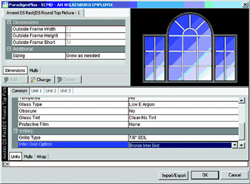Klamath Falls, Ore.–based window and door manufacturer Jeld-Wen is also boosting dealer productivity through technology. Dealers can take advantage of the firm’s Quick Quote order-entry system and then see an order’s status on Jeld-Wen’s Partners Portal, a password-protected Web page. “Partners Portal is really just a mirror image of the information we have in our internal system,” says Brent Adair, national sales manager for Jeld-Wen’s IWP Custom Door division. “When we make a change in our system, [dealers] see it in real-time.” That real-time capability is crucial in the custom manufacturing process, especially as orders evolve. “Sometimes a dealer will call us and say the customer has changed their mind and they want a different color,” Adair says. “If it’s still at a point where we can change it in our system, we’ll do that, and that change will get updated on Partners Portal. So instead of calling us back and asking us to fax them a confirmation that we changed it, they just go to Partners Portal, pull the order back up, and it’s there.”
Growing Options While the kind of manufacturer-dealer integration exemplified by Quick Quote and WindowVation is still the exception within the LBM industry, additional supply chain technology is starting to emerge. In June, Progressive Solutions, a Richmond, British Columbia–based software company whose roots lie in serving large forest products firms but that has made inroads into the LBM market with its bisTrack ERP system, announced it was acquiring Federal Way, Wash.–based ODS Software, whose core strength lies in supply chain management software for wholesale distributors of lumber and building materials. “Traditionally, Progressive focused on the left-hand side of the supply chain, such as primary and secondary producers,” says Len Williams, Progressive’s president. “ODS was more focused on the right-hand side of the supply chain, such as the wholesalers and lumber and building material distributors. This combination gives us the opportunity to address the entire supply chain.”
With that aim, Progressive now plans to roll out webTrack, an order-entry system based on technology that ODS developed for Federal Way–based Weyerhaeuser. Billed as a Web portal extension for bisTrack, the software will allow contractors to log on to pro dealers’ sites to place orders, check status, and see their accounts. It also will allow purchasing managers to connect with wholesalers and distributors who implement the system. “It’s really been designed for the professional buyer who can get on the system, get what they want, and get off,” says ODS founder Steve Littlefield, now vice president at Progressive. The firm says webTrack, available later this fall, will integrate directly with bisTrack to streamline accounting and inventory processes as well.
While Progressive’s tool aims to connect dealers more closely to contractors and suppliers, at Activant, Anderson says the firm is focusing on integrating dealers’ systems directly into the Web portals of the big builders they serve. “We have an active project where we’re examining how we can tighten the whole connection between dealers and builders,” Anderson says. The initiative aims to integrate Activant’s Falcon ERP system into builders’ scheduling portals, which they use to coordinate their construction projects. “Right now, a dealer has to go onto that builder’s Web site and look at the scheduling software to find out whatever action he needs to complete, whether it’s bidding on a new job or shipping out order No. 305. But then, the dealer has to turn around and re-key that information back into his own system,” Anderson explains. “What we’re looking at doing is automating the process so that the builder’s Web site actually [transfers that data] to the Falcon ERP system instead. There’s no technical reason why we can’t simply turn that information into an order and send it to our dispatch system with a date of request. That alone would be a huge amount of savings.”
Given the state of supply chain automation in LBM today, even a small step like that could be a big leap forward. —Joe Bousquin is a contributing editor for PROSALES.
For more tech solutions for supply chain management, see page 43.



